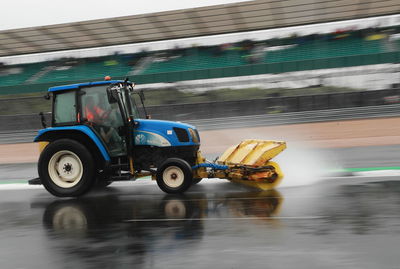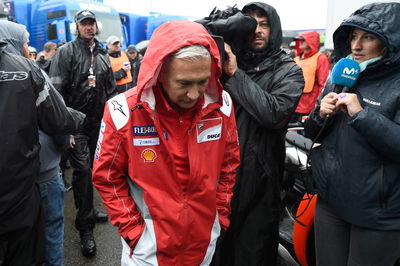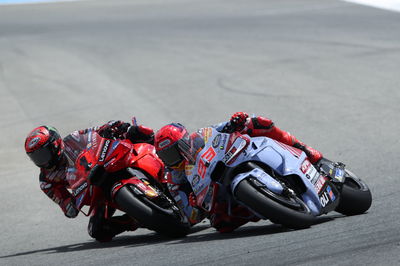Silverstone British MotoGP cancellation: The aftermath
Aggregate Industries, which conducted this year's resurfacing of the Silverstone circuit, will be 'conducting a full review' following the cancellation of Sunday's British MotoGP.
Riders were disappointed to find the new surface seemed at least as bumpy as the former asphalt when they took to the track on Friday. But the critical issue in terms of the race would be the amount of standing water that accumulated on the asphalt after rain.

Aggregate Industries, which conducted this year's resurfacing of the Silverstone circuit, will be 'conducting a full review' following the cancellation of Sunday's British MotoGP.
Riders were disappointed to find the new surface seemed at least as bumpy as the former asphalt when they took to the track on Friday. But the critical issue in terms of the race would be the amount of standing water that accumulated on the asphalt after rain.
A spokesperson at Aggregate Industries told Crash.net: "We are working in close partnership with Silverstone and will be conducting a full review of the track resurfacing over the next few days to better understand the issues caused by the extremely wet conditions on Sunday. We will continue to make resources available to assist our client during this difficult period."
Racing circuits is just one application our #asphalt division covers. We manufacture and supply British and European standardised asphalt, including our recent resurfacing work at @SilverstoneUK https://t.co/3WYBMnpkWz pic.twitter.com/ekyj29u85k
— Aggregate Industries (@AggregateUK) March 5, 2018
A brief but heavy shower on Saturday afternoon caused a spate of aquaplaning incidents at the end of the 200mph Hangar Straight, resulting in a broken leg for Tito Rabat when he was hit by Franco Morbidelli's fallen bike. The race start was then moved to try and avoid the worst of the forecast Sunday weather, alongside overnight drainage work at the Stowe/Club sections.
But, after a dry warm-up, the rain arrived and the early 11:30am start was delayed after riders again struggled with aquaplaning on their way to the grid.
Rain continued at a mostly moderate level throughout the day and, despite efforts to sweep water from the track, at a 4pm riders' meeting those present (controversially, not all of the riders) voted overwhelmingly that it would be unsafe to race.
It was the first time since 1980 that an event has been cancelled completely. The option of a Monday race was rejected by some teams due to logistical reasons, with a private test at Aragon starting on Wednesday.
Silverstone previously hosted torrentially wet MotoGP races in 2011 and 2015, prompting Race Director Mike Webb to conclude this year's problems were "a direct result of the [new] track surface."
“We’ve had a number of years of experience here in very wet conditions and with the old surface we have been able to run races," he confirmed. "This year with the new surface is the first time we’ve had quite so much standing water in critical places on the track.
“It depends entirely on the rain, how consistent and how long it is. In Moto2 practice when it was raining it was a normal session. But when the water does not drain away from the surface it builds up, so if you have had relatively light rain for a long time you get surface water.
“For the first two hours it is fine, but then [the surface water] gets worse and worse. It is a unique situation and we’ve never had to cancel a race like this.”
On Sunday evening, Silverstone Managing Director Stuart Pringle said: "I know that the contractor, Aggregate Industries, did this [resurfacing] because they are proud of their workmanship and proud of the quality of their product.
“It would be unfair to round on them now when we don’t have data. We need more data… We will of course be scanning [the track surface] again and getting some independent eyes on this as well. We need to get to the bottom of this.
“This is a serious matter for the MotoGP championship and this is a serious matter for Silverstone. We need to present answers and understand what's gone on, and what's needed for the future."
The FIM track inspection process during and after a full or partial resurfacing isn’t good enough; they need to be more involved. They are aware of my opinion but I’m yet to see change.
— Chaz Davies (@chazdavies7) August 26, 2018
While the top priority will be to fix the drainage issue, the bumps are also sure to be investigated.
FIM safety officer Franco Uncini felt 'something changed' from his first inspection of the new asphalt, when only two areas of the track needed corrective smoothing, after which it was described as 'perfect'.
“I came after they laid down the new asphalt at the end of February. At the time I did the inspection and the tarmac looked very good, a small matter of [fixing a few] bumps. A factor that was confirmed by Cal Crutchlow who did a test on a bike one month later. He confirmed two places that I said were a little bumpy.
“The circuit reacted and adjusted these two bumps and they said it was really perfect at the time. But slowly we discovered during Formula 1’s Grand Prix that it was bumpy.
“It was from March to July that was the situation of the tarmac [changed] – I don’t know what happened. They will do a deep study in the next six weeks to see what is the reason because in February and March it was good. This is the first time any asphalt did this in the past 20 seasons. It has never happened before.”
Aquaplaning
Aquaplaning is when excessive surface water causes tyres to lose contact with the track, meaning riders can no longer control their machines.
Suzuki's Alex Rins, who was seen desperately trying to warn other riders after bailing off at Stowe corner on Saturday, said:
"When I arrived I saw a lot of water and I cut the throttle in the middle of the [Hangar] straight but when I braked, the front tyre was locking fully. That means aquaplaning. But this was at 210-220 km/h so there was no time to reduce the speed and I decided to jump off the bike. Then I did all I could to warn other riders.
"Morbidelli crashed because of the aquaplaning and then his bike hit Rabat [in the gravel trap] and made him fly 3 metres. So it was bad."
'We can’t schedule a test hoping it’s going to rain'
While bumps can be easily identified during a test of the circuit with a high-performance road bike, surface drainage and aquaplaning cannot.
"The specific problem here is standing water after either continuous rain, or the very heavy short burst of rain that we had on Saturday," Webb reiterated. "Yes, we would love to have a test in those conditions before we race here but we need to find a way how. The problem is to actually technically replicate those conditions. We can’t schedule a test hoping it’s going to rain.
"After our experience in Qatar with the [artificial] wet test there, it’s an enormous exercise to wet a track sufficiently to get real data."
Uncini added: "There is no system to check the track in the wet. We check the track in the dry and we presume that in the wet it should be okay, with the correct drainage on the sides and the inclination of the track everywhere. So we only trust the company that makes the asphalt and we trust the circuit.
"We just check that is not bumpy, that it has good grip, that is not slippery, that there is no gap in-between the kerbs and the asphalt... We check all these particulars, but we cannot check in the wet because, for example, how wet is it? How would we consider that could be okay or not? Which is the system to check?
"The only system should be with a MotoGP bike on a completely wet track. Quite impossible [to test in advance]."
IMPORTANT UPDATE
— Silverstone (@SilverstoneUK) August 26, 2018
Please be reassured that we will be contacting all bookers that have been affected by today's cancellation of the event within the next week. Please take care travelling home #BritishGP
The benefit of hindsight
With hindsight, the only chance for a race on Sunday would have been before the two-hour rain 'limit' had been reached, after which the surface became waterlogged and aquaplaning occurred.
Rain began straight after MotoGP warm-up at 9:20am, meaning - despite the wise effort to change the race day schedule - the track was already soaked by the new 11:30am start time.
But with most forecasts suggesting rain from 9-10am on Sunday, could the start time not have been moved even earlier, scrapping warm-up if necessary?
"Looking at the weather forecast, the idea was the earlier the better," Webb confirmed. "We discussed about earlier starts, but the teams and more specifically the organisers need a certain amount of time to get people into the circuit in the morning and that is also a consideration. We need to consider the promoter's needs as well. The compromise and the times agreed were after consolation with all teams and the promoters."
The original race start time was 1pm.












